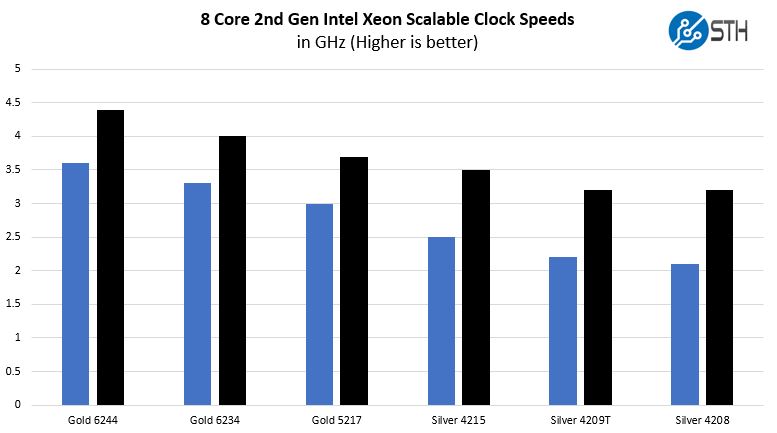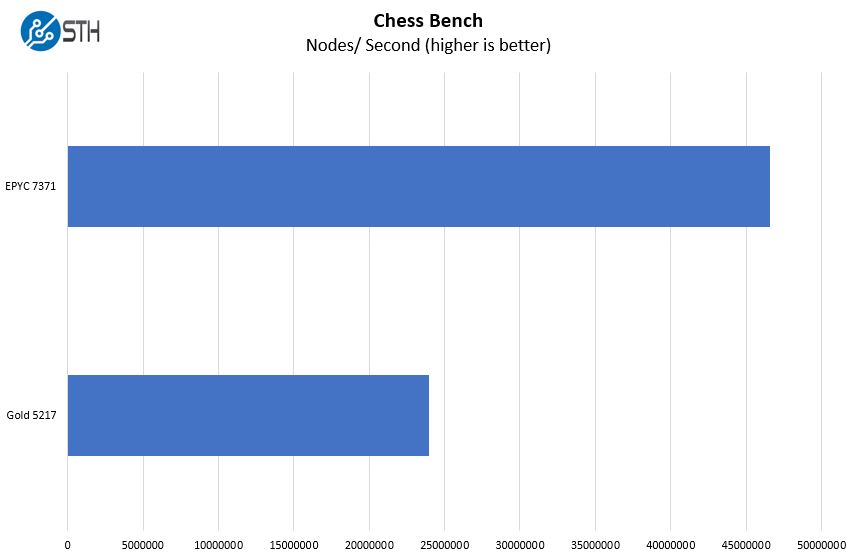Intel Xeon Gold 5217 Market Positioning
Thes chips are not released in a vacuum instead, they have competition on both the Intel and AMD sides. When you purchase a server and select a CPU, it is important to see the value of a platform versus its competitors.
Intel Xeon Gold 5217 v. Intel Alternatives
In the 8-core per socket Intel Xeon Scalable market, Intel has a large number of options with its 2nd Generation Intel Xeon Scalable line. There are six public eight core/ 16 thread SKUs which the Intel Xeon Gold 5217 is in the middle.

Higher-end Intel Xeon Gold 6244 and Gold 6234 parts have larger 25MB cache (v. 11MB on the Gold 5217.) For per-core licensed software, we think in most cases the few hundred dollar per CPU jump to the Intel Xeon Gold 6234 is warranted to get higher clock speeds and larger cache. Likewise, the Intel Xeon Silver 4208/ Silver 4209T are lower cost parts that do not really compete in this segment.
Intel Xeon Gold 5217 v. AMD EPYC Alternatives
AMD has a somewhat competitive part in the AMD EPYC 7371 Review Now The Fastest 16 Core CPU. That part is around the same price while offering 16 cores.
If we were to look at a segment where AMD has a strong single socket v. dual socket Intel comparison, this may be it. Here is an example of a single CPU to single CPU results, as we did not have dual Gold 5217 CPUs at the time of this writing.

The reason we left AMD out of most of these benchmark charts is that the Intel Xeon Gold 5217, like the Xeon Gold 6134 before it, is designed for the 8 core per socket market. The AMD EPYC 7251 is not designed for per-core performance. This is one of those cases where AMD is not competing head-to-head.
On the other hand, the AMD EPYC 7371 single socket v. dual Intel Xeon Gold 5217 is certainly an intriguing comparison as both yield clock speed optimized 16 core solutions. If we get a matching pair of Intel Xeon Gold 5217 CPUs, expect us to follow-up with a comparison.
Intel Xeon Gold 5217 v. Arm and Power Alternatives
As 8-core clock speed optimized designs for x86, Arm and Power do not have directly competing solutions in this power envelope. We expect this will change in the future, but as more of a niche segment, we do not see it as the first that players like Arm and Power will attack first.
Final Words
From a market segmentation perspective, the Intel Xeon Gold 5217 makes a lot of sense to us. The gap between the Intel Xeon Gold 6234 and Silver 4215 is too great for Intel not to have a part there. Most licensed software costs so much per core these days that it is hard not to recommend the Gold 6234 or Gold 6244 over the Gold 5217. The AMD EPYC 7371 is a wildcard here comparing two Intel Xeon Gold 5217’s to a single socket EPYC solution.
For our readers who were customers of the Intel Xeon Gold 5117 or are at VARs who have customers that used the Gold 5117, there is a big takeaway here. The core count has been dramatically reduced on the 5×17 line which is the opposite of what we have seen from other SKUs in the space.
If you do not need a frequency optimized SKU, we are going to suggest that our readers look elsewhere in the 2nd Generation Intel Xeon Scalable lineup as Intel offers more cores and more aggregate performance across those cores in this segment with other SKUs.




As if the lineup wasn’t confusing enough already with the first generation Xeon SP